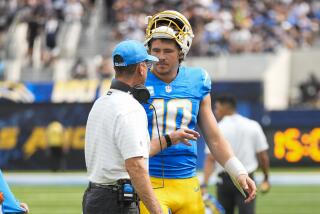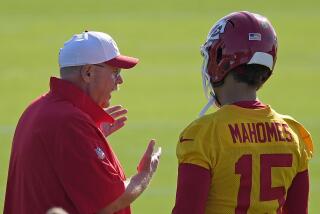Young Miami Passer Grows Up on TV
The thing that makes 1999 different in pro football is that it’s the year of the young quarterback.
And for the NFL’s numerous new young leaders, the learning curve has been a league-wide happening.
In one conspicuous case Sunday, the new Miami quarterback, Damon Huard, grew up on national television. In the first half against New England, he couldn’t make a first down in the first quarter but caught the hang of it in the second quarter and drove the Dolphins into a 10-10 halftime tie.
Learning some more in the third quarter, Huard drove the Dolphins in front with two touchdowns that made it 24-10, a lead that stood up through the rest of the NFL’s game of the week, though Huard left with a broken nose. Miami won, 27-17.
At 26, Huard, from the University of Washington, is a backup quarterback who until 1999 had thrown only nine NFL passes. Last week he could generate only three points and 101 net yards in Miami’s defeat at Buffalo, 23-3.
He’s learning.
Huard: Big Mistake to Big Play
Chances are, the Dolphins’ new, young quarterback will be watching the veteran Dan Marino in many of this season’s remaining games. But if they want him, Huard will be nourished by a remembrance of how he did it Sunday, when he progressed in 30 minutes from the big mistake to the big play.
The big mistake was a first-quarter pitch to a running back who wasn’t looking for the ball, which was fumbled into a New England lead, 7-0.
The big play was a third-down shotgun pass from Huard, a graduate of the NFL’s European league, to arena-league graduate Oronde Gadsden, a second-year Dolphin wide receiver who has been growing up along with the new passer.
That play produced 16 yards for Miami’s first first down of the game--in the second minute of the second quarter--and Huard liked it so much that in his next third-down crisis, he shotgunned it again to Gadsden, who eventually caught both of Huard’s touchdown passes.
They’re learning together.
Losing a Team Effort for Pats
The game that Huard won with critical, timely pass completions is being described in New England and Miami today in two other ways:
They’re saying Patriot quarterback Drew Bledsoe blew it with five interceptions.
Or they’re saying Miami’s defensive team won it by cleverly earning five turnovers, which, for the following reasons, is also an oversimplification:
Interception 1 came on a pass that shouldn’t have been called--or which the Patriot coaches shouldn’t have permitted--near the end of the first quarter. It was third and five at the New England nine-yard line--91 yards away from a touchdown against one of the NFL’s toughest defenses. It came at a time when New England led, 7-0, and the Miami offense had gained hardly a yard.
Interception 3 was a deflected ball that could have landed anywhere.
Interception 5 was thrown toward the end of the fourth quarter when, 10 points behind, you have to take chances.
Bledsoe’s two other turnovers did seem to be a nexus of bad calls, bad throws and good defense.
As a rule, winning and losing in the NFL is a team effort. In the last two weeks, three people have teamed to drop New England from 6-2 and first in the NFC East to 6-4 and next to last: the signal-caller, Ernie Zampese; the head coach, Pete Carroll, and Bledsoe.
McGinest Earns Himself Stiff Fine
On the play that kept Huard going 80 yards to the go-ahead touchdown, he threw incomplete on third and five but took an illegal hit from New England defensive lineman Willie McGinest, who lowered his head and plowed full steam ahead into the quarterback’s helmet.
It was a don’t-know, don’t-care move by McGinest, who, clearly, was bent on slamming the passer, hang the cost.
For unsportsmanlike conduct, the cost was 15 yards, which, if there’s any justice, the league should raise by many thousands of dollars in a fine this week.
It’s tough enough grooming young quarterbacks against legal defenses.
It’s absurd for the NFL to let the McGinests and Warren Sapps and Bill Romanowskis kill them off illegally.
The next time McGinest saw Huard in Sunday’s game, he carefully turned his head away from the passer--as he should have the first time--and swiped him with what seemed to be a legal, one-armed thrust, breaking Huard’s nose.
Ironically, that’s what knocked the young quarterback out of the game.
But there’s a big difference between a bloody nose and a concussion.
Dallas Owner Has Blown the 1990s
After the season’s first 10 weeks, the Dallas Cowboys, who haven’t reached the Super Bowl for four years, stood 5-5 and seemingly out of serious contention again.
And that was a reminder of what might have been.
The Cowboys might have won most of the Super Bowls of the 1990s if their owner, Jerry Jones, had paid whatever it took to keep Jimmy Johnson--the coach who won the 1993-94 championships for Dallas--and if Jones had paid whatever it took to keep offensive coordinator Norval Turner.
They were a great team, Jones, Johnson and Turner, and the Cowboy organizaion, the league’s richest, has generated money enough to keep them all happy into the next millennium.
The quality that makes Johnson is talent selection, as he has shown again in Miami.
The quality that makes Turner is play selection--which in Dallas made All- Pros of quarterback Troy Aikman and running back Emmitt Smith.
Johnson, however, isn’t much of a play-caller. And at Washington, Turner is a 38-51-1 head coach.
As for Jones, who thought he could do it alone, he can’t.
Put it all together and, if losing is a tragedy, it’s one of the NFL tragedies of the century.
Peyton Purest Passer Since Namath
The NFL athlete of the year in many estimates is still quarterback Peyton Manning, who has the 8-2 Indianapolis Colts in a first-place tie with Miami. He is possibly the most improved player in America since about his third year as an undergraduate at Tennessee.
Though surrounded by exceptional talent at Tennessee, Manning wasn’t all that impressive himself. He realized that fact and decided to hang in school an extra year to play for the Vols as a graduate student.
Beating Philadelphia’s 3-8 team Sunday in only three quarters, 44-17, might not have been Manning’s most marvelous all-time accomplishment, but you could see three things coming together that could, in time, lead him to the top of the NFL:
His work ethic, the sternest and most complete since Jerry Rice was a boy.
His passing motion, which makes Manning a nearly exact duplicate of Joe Namath, the Hall of Famer who invented that style, a shot-putter’s motion, replacing the roundhouse John Unitas style.
His running back, rookie Edgerrin James, who ran for 117 yards Sunday when Manning passed for 235.
Polian’s Winning Hand: Two Aces
So it’s time to honor--if that’s the right word--the executive who brought Manning and James together in Indianapolis.
He is Bill Polian, the club president who was identified three years ago by club owner James Irsay as the pro football man most likely to succeed in Indiana.
Twice in the last two drafts, Polian has had to make inordinately difficult decisions.
Last year he could have chosen either Manning or quarterback Ryan Leaf, who was to become the pride of San Diego.
This spring he could have chosen either James or running back Ricky Williams, who in the trade of the year cost the New Orleans Saints their entire 1999 draft.
Nationwide, more than one football expert criticized the Colts for passing on Leaf and more particularly on Williams.
But as Polian kept saying, Manning has the better future, certainly, and James is the better receiver.
The front-runner for AFC Rookie of the Year, James, as a receiver-running back, has in the last four weeks totaled 180, 199, 199 and 205 yards.
Thus Polian’s team was one of the first things Miami’s coach Johnson thought of after winning a big game Sunday when he said: “Indianapolis is coming on strong.”
Deflected Pass Stops Stenstrom
Deflected passes for interceptions helped beat several NFL teams Sunday, among them the hard-working San Francisco 49ers, who in the third quarter of what was then a 13-7 fight were still in sight of the NFC’s only powerhouse, the St. Louis Rams.
Down to their third quarterback, Steve Stenstrom--who replaced Jeff Garcia, who replaced Steve Young--the 49ers had parlayed a couple of first downs and were still driving when, on a second-down pass, the ball was deflected to Ram linebacker Mike Jones. Jones returned it 44 yards for a touchdown, ruining another day for San Francisco, the eventual loser, 23-7.
Scheduled against New Orleans twice in the next three weeks, the Rams continue to show that they can take sub-.500 teams in stride--which historically hasn’t been all that easy in the NFL--but they aren’t getting much practice against the kinds of players who might bother them in the playoffs and would surely trouble them in the Super Bowl.
Still, in San Francisco, the Rams again showed off a priceless commodity that will help them in the postseason: two groups of tough, active linemen, one set on offense, one on defense.
Favre Thumb, Green Bay Both Better
Two theories have been advanced in Green Bay this season for the Packers’ unexpectedly slow start, in which they’ve won only half of 10 games to stand next to last in the NFC Cenrtral.
Their new coach, Ray Rhodes, and their old quarterback, Brett Favre, have both been blamed.
It finally appeared Sunday that, until now, it has been Favre’s bruised thumb holding them back.
If you don’t keep reinjuring a bad thumb, it keeps improving, and Favre, plainly, can grip the ball again now, as anyone could see when he smiled his way through the Detroit game, coming from behind to win, 26- 17.
The go-ahead play, after Detroit quarterback Gus Frerotte had opened a 17- 12 halftime lead, was second-year Packer receiver Corey Bradford’s jumping, reaching, one-handed touchdown catch on a 17-yard play midway through the third quarter.
Bradford is a youngster who is still dropping the easy ones once in a while. Yet, Favre is back in business now because, improbably, in a highlight-film move, his new target held this one and proved it by surviving instant replay.
Selected Short Subjects:
Sports fans who censure New England passer Drew Bledsoe for throwing the game-losing interceptions Sunday could well consider this: Although Miami leads the AFC in cornerback talent with, among others, Sam Madison and Terrell Buckley, you’ve got to throw the ball sometimes and somewhere to beat any NFL team. What’s more, you’ve got to use the plays your coaches send in.
The Patriots might rank highest in the AFC in numbers of great players. Their starters are, among others, strong-armed passer Drew Bledsoe, shifty wide receivers Terry Glenn and Shawn Jefferson, tall tight end Ben Coates, an assortment of ballcarriers who out-averaged Miami’s, safetyman Lawyer Milloy, defensive end Willie McGinest and cornerbacks Ty Law and Steve Israel.
There’s clearly some coaching confusion on occasion in the New England organization, whose offensive team wasn’t ready, for one thing, to line up after an injury break on one play and had to waste another timeout. On third and 13 there, nothing wonderful was likely to happen, anyhow, and didn’t.
The Miami leader, Johnson, has put together a defensive team that reaches the point of attack faster than any other NFL defensive team. You beat that kind with misdirection plays, which New England used sometimes, but not often enough.
More to Read
Go beyond the scoreboard
Get the latest on L.A.'s teams in the daily Sports Report newsletter.
You may occasionally receive promotional content from the Los Angeles Times.










